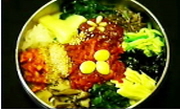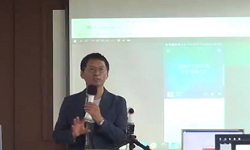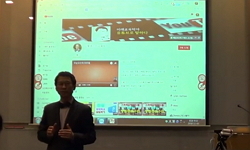This paper aimed to examine the scenery and culture of Jeonju province during the mid-19th century through Min Juhyeon’s Wansanga and his poems in classical Chinese. Although Min passed the state examination, he was appointed as a low-ranking offici...
http://chineseinput.net/에서 pinyin(병음)방식으로 중국어를 변환할 수 있습니다.
변환된 중국어를 복사하여 사용하시면 됩니다.
- 中文 을 입력하시려면 zhongwen을 입력하시고 space를누르시면됩니다.
- 北京 을 입력하시려면 beijing을 입력하시고 space를 누르시면 됩니다.

19세기 풍패지향(豊沛之鄕)의 풍경- 사애(沙厓) 민주현(閔胄顯)의 <완산가>와 전주 관련 제영시 연구 - = The Characteristics of Min Juhyeon’s Wansanga and Poems in Classical Chinese about Jeonju
한글로보기https://www.riss.kr/link?id=A106103144
- 저자
- 발행기관
- 학술지명
- 권호사항
-
발행연도
2019
-
작성언어
-
-
주제어
민주현 ; 전주 ; 완산가 ; 한벽당 ; 만경대 ; 만화루 ; 덕진지 ; 전주팔경 ; 문학지리학 ; Min Juhyeon ; Jeonju ; Wansanga ; Hanbyeokdang Pavilion ; Mangyeongdae Hill ; Manhwaru Pavilion ; Deokjinji Pond ; Eight Famous Spots of Jeonju ; Literary Geography
-
KDC
810
-
등재정보
KCI등재
-
자료형태
학술저널
- 발행기관 URL
-
수록면
31-72(42쪽)
-
KCI 피인용횟수
0
- DOI식별코드
- 제공처
- 소장기관
-
0
상세조회 -
0
다운로드
부가정보
다국어 초록 (Multilingual Abstract)
This paper aimed to examine the scenery and culture of Jeonju province during the mid-19th century through Min Juhyeon’s Wansanga and his poems in classical Chinese. Although Min passed the state examination, he was appointed as a low-ranking official named Jogyeongmyo Byeolgeom and had to stay in Jeonju for three years. In a situation where he felt politically frustrated but difficult to resign, the only way of life he could choose was to explore the attractions of Jeonju and to compose poetry. Min’s view on the topography and history of Jeonju is gathered at the beginning of Wansanga. He outlined the major geographical features of Jeonju from the southeast to the southwest. It turns out that he was aware of the origin of each place’s name as well as the topography of Jeonju. In addition, Min explained the history of Jeonju that the confusion of Gyeonhwon’s era regained order in the age of Mokjo and that Mokjo’s influence remained in his own age. In the following part of Wansanga and several poems in classical Chinese, he revealed the characteristics and significance of Jeonju’s major attractions and expressed his emotions about them. Okryudong and Hanbyeokdang are the places where the traces of Choe Dam, a renowned scholar from Jeonju, remained, so Min paid attention to these places that not only recalled the character of Choe but also had outstanding scenery. Mangyeongdae is a hill where Jeong Mongju composed a famous poem missing his king. Min honored Jeong’s loyalty here and identified himself with Jeong. Then, after looking around the pavilions of Jeonju, Min especially highlighted Gongbukru, where the local officials of Jeonju regularly greeted the king, and Manhwaru, the main gate of Jeonju Local School. In this regard, a pavilion was a space for him to strengthen his self-recognition as a literary man, rather than a place for joy. Min took a solemn and temperate appearance in the preceding places, but when he reached Deokjinji, he began to reveal the exalted inspiration. He described the beautiful scenery of Deokjinji filled with lotus flowers and enjoyed the feeling of springtime. In addition, he expressed his longing for ascending to heaven by recalling Li Po. The last scenery of Jeonju in Wansanga is the appearance of women washing clothes in the stream, and Min showed off his excitement by drawing them in the form of beautiful fairies who wash silk. The criterion that Min arranged landscapes in Wansanga is related to the characteristics of each landscape rather than the geographical proximity. After first looking around the noble places in which the traces of the renowned literary men remained, Min visited the places to strengthen his self-recognition as a literary man, and then took the way to daily places full of fascination.
목차 (Table of Contents)
- 1. 서론 2. 작품 창작의 경위 3. 전주의 지세와 역사에 관한 인식 4. 민주현의 눈에 비친 19세기 전주의 풍광과 문화 5. 결론
- 1. 서론 2. 작품 창작의 경위 3. 전주의 지세와 역사에 관한 인식 4. 민주현의 눈에 비친 19세기 전주의 풍광과 문화 5. 결론
참고문헌 (Reference)
1 정훈, "한벽당 제영시 연구" 우리어문학회 (27) : 205-228, 2006
2 서인숙, "한국문집총간해제 11" 한국고전번역원 2013
3 김갑기, "한국 제영시 연구(Ⅰ)" 한국문학연구소 (12) : 243-268, 1989
4 "풍아"
5 "태조실록 권1"
6 조수삼, "추재집 권3"
7 "청구영언(진본)"
8 "철종실록 권8"
9 김규남, "지명으로 보는 전주 100년" 신아 2002
10 박준규, "조선전기全北의樓亭題詠攷" 전남대호남학연구소 (25) : 251-283, 1997
1 정훈, "한벽당 제영시 연구" 우리어문학회 (27) : 205-228, 2006
2 서인숙, "한국문집총간해제 11" 한국고전번역원 2013
3 김갑기, "한국 제영시 연구(Ⅰ)" 한국문학연구소 (12) : 243-268, 1989
4 "풍아"
5 "태조실록 권1"
6 조수삼, "추재집 권3"
7 "청구영언(진본)"
8 "철종실록 권8"
9 김규남, "지명으로 보는 전주 100년" 신아 2002
10 박준규, "조선전기全北의樓亭題詠攷" 전남대호남학연구소 (25) : 251-283, 1997
11 김승우, "조선시대시가의현상과변모" 보고사 503-535, 2017
12 김종직, "점필재집 권22"
13 노재현, "전주팔경의 시원(始原)과 변용(變容)에 관한 연구" 한국전통조경학회 33 (33): 1-15, 2015
14 홍성덕, "전주의 기맥을 지키는 덕진공원"
15 이우갑, "전주관련한시연구: 왕실본향이미지를중심으로" 전북대 2015
16 "용비어천가 권1"
17 노재현, "역사경관의 이미지 형성 과정으로 본 寒碧堂" 한국전통조경학회 5 : 52-64, 2007
18 "신증동국여지승람 권33"
19 "승정원일기"
20 "세종실록 권151"
21 민주현, "사애집 권1, 6"
22 서거정, "사가시집 권45; 사가문집 권2"
23 김승우, "목조(穆祖) 이안사(李安社)에 관한 전승 연구 -장군수(將軍樹) ․ 호운석(虎隕石) 설화의 특징과 전승 양상-" 한국문학언어학회 (74) : 189-217, 2017
24 정훈, "만경대에 형성된 호남 충(忠)의 이미지" 호남학연구원 (48) : 351-378, 2010
25 "동국통감 권13"
26 "금옥총부"
27 송치규, "강재집 권8"
28 "輿地圖書"
29 하성래, "沙厓閔胄顯의 完山歌攷" 명지대 국어국문학과 16 : 193-227, 1984
30 하성래, "完山謌" 한국언어문학회 (5) : 53-56, 1968
31 "完山誌 卷上"
32 全州府, "全州府史" 全州府 1943
33 구사회, "『시조책』(김해정 소장본)과 새로운 시조 작품에 대하여" 한국시가문화학회 (39) : 5-31, 2017
34 곽지숙, "<한벽당십이곡>과조선후기누정문화" 숙명여대 한국어문화연구소 (10) : 35-62, 2011
35 김신중, "<완산가>의 전승과 변이 고찰" 한국시가문화학회 (24) : 19-39, 2009
동일학술지(권/호) 다른 논문
-
연암 박지원의 ‘소문’ 활용 양상 연구- 「호질」 , 「김신선전」 , 「열녀함양박씨전」 을 중심으로 -
- 한국언어문학회
- 김영미(Kim, Young-mi)
- 2019
- KCI등재
-
- 한국언어문학회
- 김보향(Kim, Bo-hyang)
- 2019
- KCI등재
-
- 한국언어문학회
- 서희정
- 2019
- KCI등재
-
김득연(金得硏)의 계회(契會) 활동과 <산중잡곡(山中雜曲)>의 창작 맥락
- 한국언어문학회
- 이승준
- 2019
- KCI등재
분석정보
인용정보 인용지수 설명보기
학술지 이력
| 연월일 | 이력구분 | 이력상세 | 등재구분 |
|---|---|---|---|
| 2028 | 평가예정 | 재인증평가 신청대상 (재인증) | |
| 2022-01-01 | 평가 | 등재학술지 유지 (재인증) |  |
| 2019-01-01 | 평가 | 등재학술지 유지 (계속평가) |  |
| 2016-01-01 | 평가 | 등재학술지 선정 (계속평가) |  |
| 2015-12-01 | 평가 | 등재후보로 하락 (기타) |  |
| 2011-01-01 | 평가 | 등재학술지 유지 (등재유지) |  |
| 2009-01-01 | 평가 | 등재학술지 유지 (등재유지) |  |
| 2007-01-01 | 평가 | 등재학술지 유지 (등재유지) |  |
| 2005-01-01 | 평가 | 등재학술지 유지 (등재유지) |  |
| 2002-01-01 | 평가 | 등재학술지 선정 (등재후보2차) |  |
| 1999-07-01 | 평가 | 등재후보학술지 선정 (신규평가) |  |
학술지 인용정보
| 기준연도 | WOS-KCI 통합IF(2년) | KCIF(2년) | KCIF(3년) |
|---|---|---|---|
| 2016 | 0.31 | 0.31 | 0.28 |
| KCIF(4년) | KCIF(5년) | 중심성지수(3년) | 즉시성지수 |
| 0.3 | 0.32 | 0.556 | 0.11 |





 KCI
KCI 스콜라
스콜라






